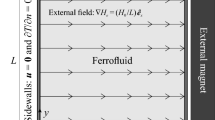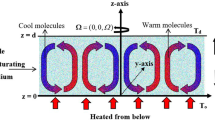Abstract—
The main advantages of the energy approach to solving the problem of determining magnetic forces acting on solid bodies immersed into magnetized ferrofluids (FFs) are shown. Characteristic disadvantages of the standard approach to the calculation of magnetic forces using the Bernoulli equation for FFs and an equation for the magnetic pressure jump at the interface are considered. A review of works devoted to the study of forces acting on solid bodies immersed in magnetized FFs is presented. This literature review convincingly demonstrates the need for and potential advantage of using the energy approach to these problems, since the analytical expressions significantly depend on the body shape and obtaining the final numerical results is complicated by the error of magnetic field calculation at the “solid body–FF” interface where the normal component of induction and the tangential component of the magnetic field exhibit a discontinuity. In contrast, the energy approach allows using the standard functions of program packages for determining thermodynamic potentials. The choice of a thermodynamic potential correctly describing experimental data is discussed. The method of magnetic energy determination is justified by the problem setting and verified by comparison of the results of several numerical solutions obtained using the open software package FEMM for FFs obeying a nonlinear magnetization law. This analysis was previously performed neither experimentally nor theoretically in view of the commonly accepted use of simplifying assumptions (approximations of weak and strong magnetic fields or a noninductive approximation). Here, the energy approach to determining forces acting on solid bodies in FFs has been justified by pairwise comparison of the results obtained in the framework of this approach to the data of laboratory experiment and the results of standard calculations.




Similar content being viewed by others
REFERENCES
Rosensweig, R.E., Ferrohydrodynamics, Cambridge: Cambridge Univ. Press, 1985.
Rosensweig, R.E., Buoyancy and stable levitation of a magnetic body immersed in a magnetizable fluid, Nature (London, U.K.), 1966, vol. 210, pp. 613–614. https://doi.org/10.1038/210613a0
Rosensweig, R.E., Fluid magnetic buoyancy, AIAA J., 1966, vol. 4, pp. 1751–1758. https://doi.org/10.2514/3.3773
Berkovsky, B.M., Medvedev, V.F., and Krakov, M.S., Magnetic Fluids: Engineering Applications, Oxford: Oxford Univ. Press, 1993.
Pshenichnikov, A.F., Mekhonoshin, V.V., and Lebedev, A.V., Magneto-granulometric analysis of concentrated ferrocolloids, J. Magn. Magn. Mater., 1996, vol. 161, pp. 94–102. https://doi.org/10.1016/S0304-8853(96)00067-4
Ivanov, A.O. and Kuznetsova, O.B., Magnetogranulometric analysis of ferrocolloids: Second-order modified mean field theory, Colloid. J., 2006, vol. 68, pp. 430–440. https://doi.org/10.1134/S1061933X06040065
Cebers, A.O., in Proceedings of the 9th Riga Conference on Magnetohydrodynamics, Salaspils, 1978, vol. 3, pp. 129–130.
Blums, E., Cebers, A., and Maiorov, M.M., Magnetic Fluids, Berlin: Walter de Gruyter, 1997.
Vislovich, A.N., and Krakov, M.S., in Proceedings of the 11th Riga Conference on Magnetohydrodynamics, Riga, 1984, vol. 3, pp. 187–190.
Vislovich, A.N., Lobko, S.I., and Lobko, G.S., Interaction of solid bodies suspended in a magnetic liquid in a homogeneous magnetic field, Magnetohydrodynamics, 1986, vol. 22, no. 4, pp. 377–384. https://doi.org/10.22364/mhd
Kvitantsev, A.S., Naletova, V.A., and Turkov, V.A., Levitation of magnets and paramagnetic bodies in vessels filled with magnetic fluid, Fluid Dyn., 2002, vol. 37, pp. 361–368. https://doi.org/10.1023/A:1019698205112
Naletova, V.A., Kvitantsev, A.S., and Turkov, V.A., Movement of a magnet and a paramagnetic body inside a vessel with a magnetic fluid, J. Magn. Magn. Mater., 2003, vols. 258–259, pp. 439–442. https://doi.org/10.1016/S0304-8853(02)01089-2
Pelevina, D.A., Sharova, O.A., Merkulov, D.I., Turkov, V.A., and Naletova, V.A., Spherical magnetizable body partially immersed in a magnetic fluid in a uniform magnetic field, J. Magn. Magn. Mater., 2020, vol. 494, p. 165751. https://doi.org/10.1016/j.jmmm.2019.165751
Qian, L. and Li, D., Use of magnetic fluid in accelerometers, J. Sensor., 2014, vol. 2014, p. 375623. https://doi.org/10.1155/2014/375623
Gogosov, V.V., Smolkin, R.D., Krokhmal’, V.S., Saiko, O.P., Mangov, L.I., and Nozkodubov, V.I., Industrial separators based on magnetic fluids (a survey), Magnetohydrodynamics, 1994, vol. 30, no. 1, pp. 96–103. https://doi.org/10.22364/mhd
Coulomb, J.L., A methodology for the determination of global electromechanical quantities from a finite element analysis and its application to the evaluation of magnetic forces, torques and stiffness, IEEE Trans. Magn., 1983, vol. 19, no. 6, pp. 2514–2519. https://doi.org/10.1109/TMAG.1983.1062812
Henrotte, F. and Hameyer, K., Computation of electromagnetic force densities: Maxwell stress tensor vs. virtual work principle, J. Comput. App. Math., 2004, vol. 168, pp. 235–243. https://doi.org/10.1016/j.cam.2003.06.012
Pshenichnikov, A.F. and Burkova, E.N., Effect of demagnetizing fields on particle spatial distribution in magnetic fluids, Magnetohydrodynamics, 2012, vol. 48, pp. 503–514. https://doi.org/10.22364/mhd.48.3.4
Pshenichnikov, A.F. and Burkova, E.N., On influence of magnetophoresis and interparticle interactions on floating of permanent magnet in magnetic fluid, Vestn. Perm. Univ., Fiz., 2016, no. 34 (3), pp. 32–41. https://doi.org/10.17072/1994-3598-2016-3-32-41
Landau, L.D. and Lifshitz, E.M., A Course of Theoretical Physics, Vol. 8: Electrodynamics of Continuous Media, Oxford: Pergamon, 1960.
Khokhryakova (Bushueva), C.A., Pshenichnikov, A.F., and Lebedev, A.V., Determination of the weight of a non-magnetic body, immersed in a magnetic fluid exposed to uniform magnetic fluid, Magnetohydrodynamics, 2019, Vol. 55, pp. 73–78. https://doi.org/10.22364/mhd.55.1-2.9
Meeker, D., Improvised open boundary conditions for magnetic finite elements, IEEE Trans. Magn., 2013, vol. 49, no. 10, pp. 5243–5247. https://doi.org/10.1109/TMAG.2013.2260348
Author information
Authors and Affiliations
Corresponding author
Additional information
Translated by P. Pozdeev
Rights and permissions
About this article
Cite this article
Ivanov, A.S. An Energy Approach to the Calculation of Forces Acting on Solid Bodies in Ferrofluids. J Appl Mech Tech Phy 62, 1190–1198 (2021). https://doi.org/10.1134/S0021894421070105
Received:
Revised:
Accepted:
Published:
Issue Date:
DOI: https://doi.org/10.1134/S0021894421070105




